Corals of the Great Barrier Reef: Ecology and Challenges
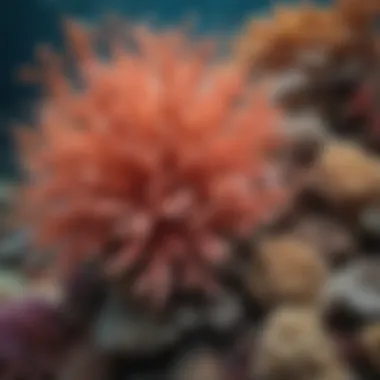
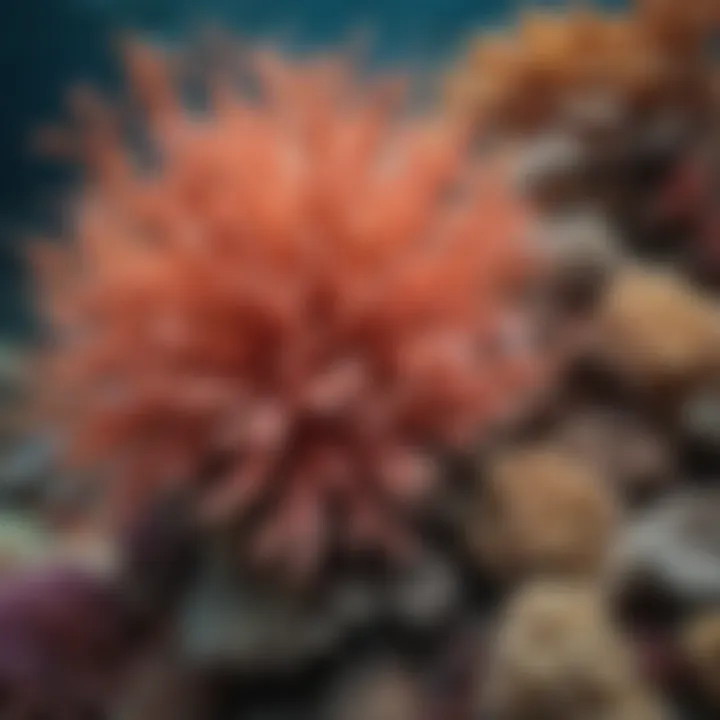
Intro
The Great Barrier Reef, recognized as one of the most complex ecosystems on Earth, is home to a diverse array of coral species. Corals play a critical role in maintaining the health of marine environments. They provide habitat for countless marine organisms, which in turn supports biodiversity. Understanding the factors that influence coral health is increasingly urgent as these ecosystems face mounting pressures from climate change, pollution, and human activities.
Through this article, we will delve deeply into the various dimensions of corals in the Great Barrier Reef. Emphasis will be placed on ecological significance, species diversity, and the serious threats these ecosystems encounter. The need for innovative conservation efforts becomes unmistakable when considering the implications of ongoing environmental changes.
We aim to engage students, researchers, educators, and professionals with insightful analyses that reflect the importance of this subject.
Key Findings
- Summary of the main results
The corals of the Great Barrier Reef exhibit remarkable biodiversity. Over 400 species of hard corals inhabit this region, contributing to its status as a UNESCO World Heritage site. Recent research indicates that climate change is the most significant threat, leading to coral bleaching events that compromise their survival. - Significance of findings within the scientific community
The implications for these findings extend beyond mere awareness. They underscore a collective urgency among scientists, policymakers, and conservationists to act promptly in mitigating these threats. The Great Barrier Reef serves as a benchmark for studying coral ecosystems globally.
Implications of the Research
- Applications of findings in real-world scenarios
The findings have transformative potential in shaping conservation strategies. For example, implementing marine protected areas has proved effective in safeguarding vulnerable coral populations. Awareness initiatives can also be developed to educate the public about the importance of corals and sustainable practices. - Potential impact on future research directions
Further studies could illuminate unknown aspects of coral resilience and adaptability. Investigating genetic diversity among coral species may yield vital insights into enhancing their survival against climate change.
"The health of coral reefs is a reflection of the ocean’s wellbeing."
In summary, the Great Barrier Reef's coral ecosystems are under significant threat. However, understanding these challenges opens avenues for meaningful engagement and conservation actions. We must prioritize these efforts for the sake of ecology and humanity.
Prolusion to the Great Barrier Reef
The Great Barrier Reef, stretching over 2,300 kilometers off the Queensland coast in Australia, serves as one of the most critical marine ecosystems on the planet. This section illuminates the geographical significance and ecological importance of coral reefs within this vast and complex structure. Understanding these elements is essential, as it lays the groundwork for discussions about species diversity, ecological roles, and the multitude of threats faced by this fragile environment.
Geographical Overview
The Great Barrier Reef is not only the largest coral reef system in the world but also a UNESCO World Heritage site. It encompasses roughly 344,400 square kilometers, consisting of over 2,900 individual reefs and 900 islands. Its geographical layout includes various ecosystems, such as lagoons, seagrass beds, and mangrove forests, which together support a rich biodiversity.
The reef's location plays a crucial role in its ecological dynamics. Situated in a tropical climate, the region experiences warm waters, which are vital for coral health and growth. The reef acts as a natural barrier, protecting the coastline from wave action, which mitigates beach erosion and sediment deposition.
Many marine species depend on the Great Barrier Reef for survival, including fish, mollusks, and marine mammals. The interconnectedness of these ecosystems emphasizes the importance of preserving the reef, as deterioration in one area can lead to broader ecological consequences.
Significance of Coral Reefs
Coral reefs are often referred to as the rainforests of the sea because of their astonishing biodiversity and complex ecosystems. They provide habitats for countless marine organisms and play essential roles in nutrient cycling. Furthermore, corals contribute substantially to the economy through tourism and fishing industries.
The significance of coral reefs extends beyond their aesthetic value. They serve as essential buffers protecting coastal areas from storm surges and erosion. This not only preserves local ecosystems but also safeguards human communities residing near the coast. These benefits highlight the urgent need for effective conservation measures.
"Coral reefs support approximately 25% of all marine species, emphasizing their ecological significance and the need for concerted conservation efforts."
In summary, the introduction to the Great Barrier Reef emphasizes the need to understand the geographical and ecological contexts of coral reefs. Such knowledge provides a foundation for exploring the rich diversity of species, their ecological roles, and the pressing threats they face.
Coral Species Diversity
Coral species diversity is vital for understanding the overall health and sustainability of the Great Barrier Reef. This diversity supports ecological balance and resilience against environmental changes. Each species plays a unique role in the reef's ecosystem, from providing habitat to supporting food webs. The Great Barrier Reef is home to over 400 species of coral. This diversity is not only important for the marine species that depend on corals but also for human communities that rely on healthy reefs.
Major Coral Families
Among the diverse corals, the major families include Acroporidae, foraminifera, and Faviidae. Acroporidae, or staghorn corals, are among the fastest-growing and are crucial for reef formation. They provide essential habitats for fish and other marine life. Faviidae, or brain corals, are slower-growing but play vital roles in biodiversity and structural integrity of the reef. These families are essential for maintaining the reef structure and ecosystem functions.
Endemic Species
Certain coral species are endemic to the Great Barrier Reef. This means they are not found anywhere else in the world. Endemic species enhance local biodiversity, making the reef unique. Examples include Acropora millepora, which is known for its fast growth and ability to adapt to varying conditions. The presence of endemic species indicates a healthy ecosystem and contributes to the cultural significance of the reef.
Threatened Species
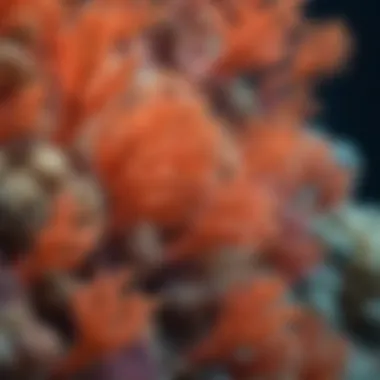
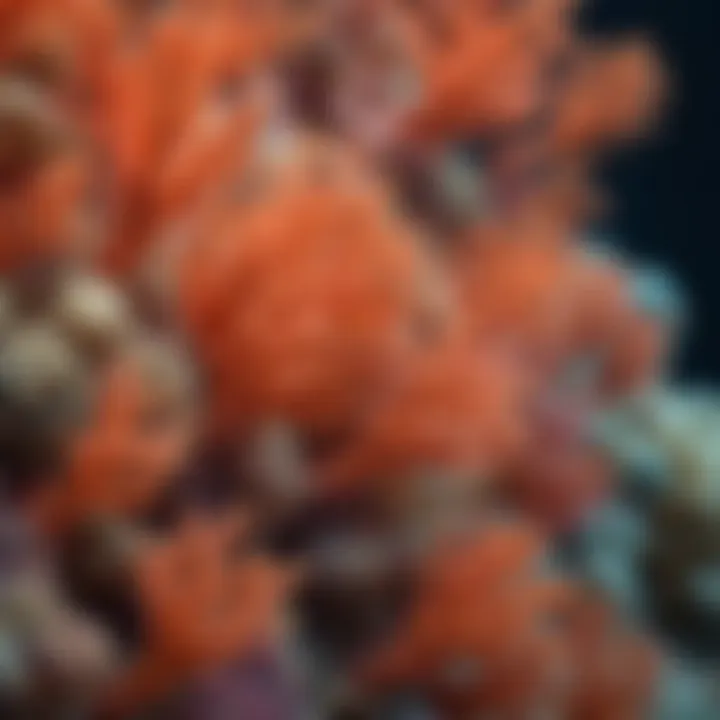
The Great Barrier Reef faces challenges from various anthropogenic activities. Some coral species are classified as threatened. The World Wildlife Fund highlights that species like Montastraea faveolata, known as the mountainous star coral, are vulnerable due to climate change and pollution. Protecting these threatened species is critical. Conservation efforts can help prevent further loss and encourage recovery.
"The health of coral species directly affects the entire marine ecosystem, showcasing their significance beyond just their beauty."
Understanding coral species diversity is essential in addressing issues like climate change and developing effective conservation strategies. The future of the Great Barrier Reef depends on the protection of its diverse coral species, underscoring the need for ongoing research and commitment to preservation efforts.
Ecological Roles of Corals
Corals are foundational species in marine ecosystems, particularly in the Great Barrier Reef. Their ecological roles are multifaceted, influencing not only the health of the reef but also the overall biodiversity of the ocean. In this section, we will delve into two major roles: the provision of habitats for diverse marine life and their part in nutrient cycling. Each of these functions underscores the vital contribution corals make to the marine environment.
Habitats for Marine Life
Corals provide essential habitats for a vast array of marine organisms. They host thousands of species, including fish, invertebrates, and algae. The complex three-dimensional structures of coral reefs create sheltered environments in which numerous marine species can reside. These structures offer protection from predators and serve as breeding grounds.
Many species, such as clownfish, depend on specific types of corals, like Anemone corals, for shelter. Here, they find safety from larger fish, while also providing beneficial nutrients to corals through waste. This relationship highlights a mutualistic interaction, emphasizing how corals aid in maintaining fish populations, which in turn supports broader reef health.
Additionally, corals play a role in the food web. Without coral reefs, many marine species would struggle to find suitable habitats, leading to decreased biodiversity. A loss of biodiversity can have cascading effects on marine ecosystems and can alter the ecological balance of the reef.
Nutrient Cycling
Corals contribute significantly to nutrient cycling within marine ecosystems. They enhance the productivity of the waters surrounding them through various processes. Coral reefs serve as nursery grounds where juvenile fish can grow, benefiting from the nutrient-rich waters generated by the corals themselves.
Corals engage in symbiotic relationships with zooxanthellae, a type of algae that lives within their tissues. These algae perform photosynthesis, providing corals with essential nutrients. In return, corals offer protection and access to sunlight, which is crucial for photosynthesis. This relationship not only sustains the corals but also amplifies the reef's overall nutrient availability.
The breakdown of organic material from coral and other reef organisms releases vital nutrients back into the water, creating a cycle that supports diverse marine life. Without this cycling, nutrient depletion could occur, collapsing the delicate balance of reef ecosystems.
"Corals are not just living structures but vital, functioning members of the marine community, influencing everything from fish populations to nutrient dynamics."
Coral Physiology and Growth
Understanding coral physiology and growth is crucial for several reasons. Corals are not just beautiful marine organisms; they are complex ecosystems that provide essential services to marine life and humans alike. Their unique biological processes and growth rhythms are directly linked to their health and sustainability. This section delves into the anatomy of corals and their symbiotic relationships, which are pivotal in their survival and proliferation.
Coral Anatomy
Coral anatomy comprises several key components that contribute to their function in the marine ecosystem. The structure of a coral polyp is simple yet remarkably effective. Each polyp has a cylindrical body topped with tentacles that contain stinging cells called nematocysts. These tentacles serve for capturing food, primarily plankton, as well as providing defense against predators.
The base of the polyp is attached to a solid surface, forming colonies that can consist of thousands of individual polyps interconnected. Corals also have a skeleton made primarily of calcium carbonate, which forms the foundation of coral reefs. This mineral skeleton is critical as it not only protects the coral but also contributes to the structural integrity of the reef itself, allowing it to withstand powerful ocean currents.
The intricate structure of coral polyps allows them to adapt to varying environmental conditions, demonstrating a remarkable example of biological resilience.
Symbiotic Relationships
Corals engage in various symbiotic relationships that are vital for their survival. The most notable of these symbionts are zooxanthellae and other microorganisms.
Zooxanthellae
Zooxanthellae are a type of dinoflagellate algae that live within the tissues of coral polyps. This relationship is a classic example of mutualism; the algae benefit from a protected environment, while the corals receive essential nutrients produced through photosynthesis. One key characteristic of zooxanthellae is their ability to harness sunlight, converting it to energy that supports both their own growth and that of their coral hosts.
The unique feature of zooxanthellae is their role in regulating the energy supply of corals. During times of stress, such as increased water temperature or pollution, these algae can be expelled. This expulsion leads to coral bleaching, a condition that can result in coral mortality. Thus, understanding the role of zooxanthellae is fundamental to comprehending coral physiology and health. Their dependency on light and nutrient cycling makes them a crucial focus of this article.
Other Symbionts
In addition to zooxanthellae, corals host a variety of other symbionts, including bacteria and other microorganisms. These entities contribute to coral health by participating in nutrient cycling and enhancing the resilience of corals to environmental stressors. A key characteristic of these other symbionts is their capacity to break down organic matter, which supports coral nutrition and fosters a beneficial environment within the reef.
A notable advantage of these symbiotic relationships is their contribution to coral reef biodiversity. Different microorganisms can bolster overall ecosystem health, making the coral more robust in the face of challenges from climate change and pollution. Understanding the intricate dynamics of these additional symbionts adds depth to the study of coral biology, revealing how interconnected ecosystems can sustain themselves.
"Coral reefs are some of the most diverse ecosystems on the planet. Their sustainability is directly tied to the symbiotic relationships they foster."
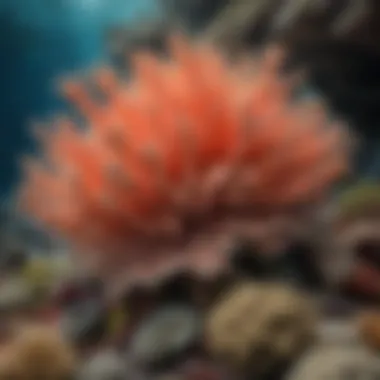
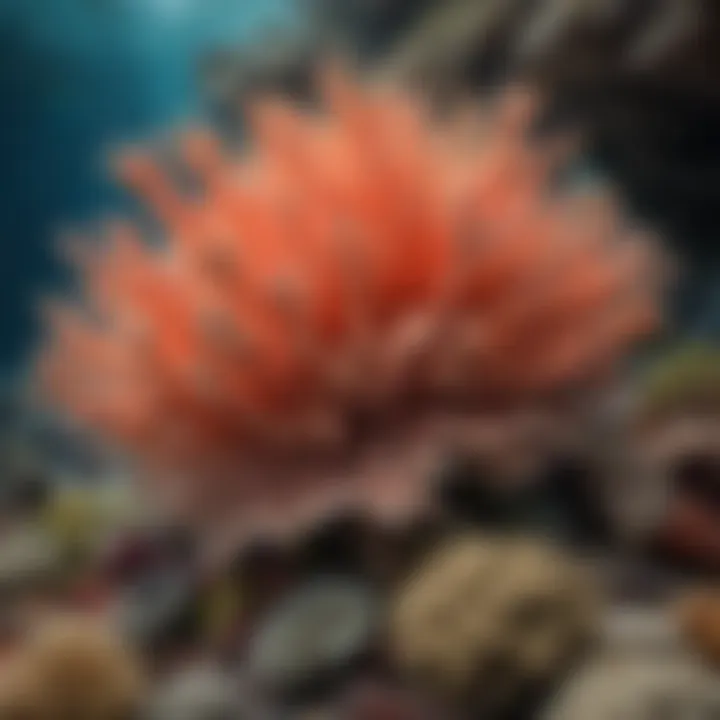
In summary, the physiology and growth of corals intricately connect to their anatomical structures and symbiotic relationships. Both aspects are essential for maintaining the health and stability of coral reefs. A comprehensive understanding of coral anatomy and association with zooxanthellae and other symbionts is vital for addressing the threats faced by these important ecosystems.
Threats to Coral Health
Corals are integral to the ecosystem of the Great Barrier Reef, but they face numerous threats that endanger their survival. Understanding these threats is crucial in recognizing the challenges that exist for coral health. This section will delve into the prominent issues affecting corals, with a focus on climate change, pollution, and overfishing.
Climate Change Impact
Climate change has become a significant threat to coral reefs globally. Rising ocean temperatures lead to coral bleaching, a phenomenon where corals expel the symbiotic algae living in their tissues. These algae provide essential nutrients through photosynthesis. Without them, corals lose their color and vitality, making them more susceptible to disease and mortality.
Additionally, increased levels of carbon dioxide in the atmosphere result in ocean acidification. Lower pH levels hinder coral growth, making it difficult for them to form their calcium carbonate structures. This has serious implications not just for corals but for the entire marine ecosystem that relies on them.
The consequences of climate change don’t only affect marine life directly. For instance, it's expected that extreme weather events, such as storms and cyclones, will become more frequent and severe, further damaging the reef structure and its inhabitants.
Pollution Effects
Pollution poses a dire threat to coral health. Various forms of pollutants enter the ocean, negatively impacting corals' ability to thrive. Nutrients from agricultural runoff, for instance, can lead to algal blooms. These blooms can choke corals, blocking sunlight necessary for photosynthesis and depleting the oxygen levels in surrounding waters.
Chemical pollutants, such as heavy metals and pesticides, disrupt the biological processes of corals. They affect the health of the corals and their associated ecosystems. Plastics and other waste materials also pose significant risks, as they can smother corals and introduce harmful toxins.
"The Great Barrier Reef is often viewed as a delicate system, and pollution serves to exacerbate its vulnerabilities."
Overfishing Implications
Overfishing is a critical issue that affects coral reefs. The removal of key fish species disrupts the balance of the ecosystem. Fish play a vital role in controlling algae growth and maintaining the health of coral reefs. With the decline of certain fish populations, there is often an unchecked increase in algae, which can overtake and damage coral reefs.
Moreover, overfishing can lead to altered food webs, making it harder for coral species to recover from disturbances. Unsustainable fishing practices, including the use of destructive gear, can physically damage the reefs, worsening their overall health.
An integrated approach to address these threats is necessary. Understanding the impacts of climate change, pollution, and overfishing on coral health is vital. By recognizing these threats, appropriate conservation strategies can be developed to protect and sustain the Great Barrier Reef.
Conservation Efforts
Conservation efforts are central to sustaining the health of the Great Barrier Reef and its coral ecosystems. These initiatives aim not only to protect the corals themselves but also to restore the delicate balance of each habitat that surrounds them. Effective conservation is vital due to the increasing threats posed by climate change, pollution, and overexploitation of marine resources. Engaging in comprehensive conservation strategies helps mitigate these impacts and fosters resilience within coral communities.
International Agreements
International agreements play a crucial role in global efforts to protect coral reefs. Various conventions and accords provide frameworks for nations to collaborate on conserving marine biodiversity. For instance, the Convention on Biological Diversity emphasizes the significance of coral reefs under the auspices of sustainable development. This agreement sets guidelines for member states to enact legislation and policies that safeguard marine environments. Moreover, treaties such as the Paris Agreement recognize the impact of climate change on reef health, urging nations to commit to reducing greenhouse gas emissions. Participating countries can uphold the collective responsibility towards coral conservation through coordinated actions.
Local Conservation Programs
Local conservation programs are equally essential for addressing region-specific challenges faced by the Great Barrier Reef. Various organizations and community groups engage in practices like reef restoration and monitoring water quality. Programs often focus on educating local stakeholders, including fishermen and tourism operators, about sustainable practices. Collaboration among local governments, research institutions, and the public enhances the effectiveness of these initiatives. Efforts such as community reef clean-ups and the establishment of marine protected areas aim to alleviate stress on corals and promote regeneration of damaged habitats. Such localized initiatives can create adaptive management strategies that consider both ecological and socio-economic factors.
Overall, both international agreements and local conservation programs are indispensable for ensuring the longevity and resilience of the Great Barrier Reef's coral ecosystems.
Future Directions for Coral Research
Coral research is crucial in understanding the resilience of the Great Barrier Reef against various threats. As conditions for coral health fluctuate due to climate change, it becomes imperative to explore new methodologies that can aid coral restoration and preservation. Future research should focus on innovative techniques that not only address immediate ecological concerns but also facilitate long-term sustainability for these ecosystems. In addition to these strategies, consistent monitoring will be essential to track the effectiveness of restoration efforts and adapt strategies accordingly.
Innovative Restoration Techniques
Innovative restoration techniques form a pivotal part of ongoing research dedicated to coral reefs. These methods aim to replenish damaged areas, utilizing both biological and technological advancements to rejuvenate populations. For instance, scientists are experimenting with coral farming, where healthy coral species are cultivated in controlled environments before being transplanted back to reefs. This enhances genetic diversity and boosts resilience against environmental stressors. Moreover, researchers are utilizing artificial reefs made from eco-friendly materials to provide an initial framework for coral colonization. This approach not only accelerates recovery but also improves habitat complexity, which is vital for marine biodiversity.
Long-term Monitoring
Long-term monitoring is essential in the realm of coral research. It allows for an in-depth understanding of the effectiveness of various conservation methods over extended periods. This practice includes utilizing remote sensing technology to analyze coral health and species distribution continuously. Regular data collection enables researchers to establish trends, making it easier to predict future changes in reef ecosystems. Furthermore, community involvement in monitoring initiatives fosters a sense of stewardship among local populations. By integrating local knowledge with scientific data, researchers can develop more tailored strategies to address specific challenges facing the Great Barrier Reef.
The integration of innovative techniques and long-term monitoring is vital for the future of coral reefs, ensuring their survival amidst increasing threats.

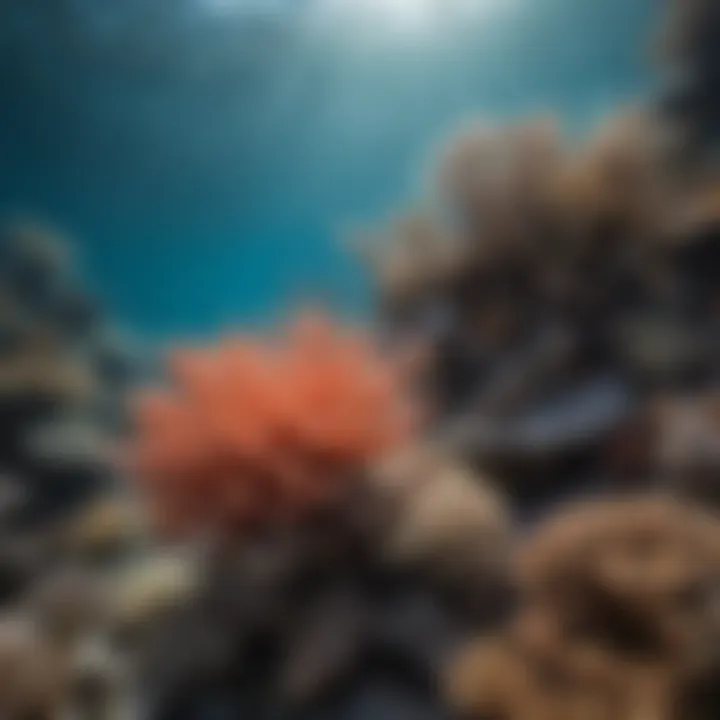
This combined approach not only increases the likelihood of success for restoration projects but also enhances our scientific understanding, which is crucial for making informed decisions in coral conservation.
The Role of Technology in Coral Research
Technology plays a crucial role in advancing our understanding of coral ecosystems. As coral reefs face numerous threats, the application of modern technology becomes essential for monitoring, data collection, and conservation efforts. Utilizing diverse technological tools allows researchers to gather data more efficiently and accurately. This not only aids in assessing coral health but also helps in understanding the broader impacts of climate change and human activity on these vital ecosystems.
The integration of technology also enhances collaboration among scientists, policymakers, and conservationists. By providing real-time data, technological solutions can facilitate timely decisions and improve conservation strategies. In essence, technology bridges gaps in our knowledge and fosters a more informed approach to coral reef preservation.
Remote Sensing in Monitoring
Remote sensing is an innovative method that employs satellite imagery and aerial photography to monitor coral reefs. This technology allows scientists to observe changes in coral coverage, health, and the surrounding marine environment over vast areas. By capturing data on water temperature, salinity, and chlorophyll concentration, remote sensing helps in identifying stressors affecting coral ecosystems.
One notable advantage of remote sensing is its capacity to conduct large-scale assessments of coral reefs without the need for extensive on-site research. This is particularly valuable given the vastness of the Great Barrier Reef. Scientists can analyze patterns over time, revealing trends that may indicate declining health or recovery efforts.
Additionally, remote sensing can identify areas most vulnerable to threats, enabling targeted conservation efforts. As a result, this technology is indispensable for developing effective management strategies to protect coral habitats.
Data Collection Methods
Data collection methods are fundamental to understanding the condition of coral reefs. Various techniques are employed to gather information on coral species diversity, health indicators, and ecological interactions. Traditional methods like underwater surveys and visual assessments provide valuable insights but can be time-consuming and resource-intensive.
With advancements in technology, many researchers now utilize tools such as:
- Underwater Drones: These devices capture high-resolution images of coral reefs and allow for flexible movement in hard-to-reach areas.
- Environmental Sensors: They measure critical parameters like temperature, pH, and dissolved oxygen levels, providing continuous monitoring data.
- Citizen Science Programs: Engaging communities in data collection efforts can enhance local involvement and broaden the scope of research.
Utilizing a combination of these methods enables a more comprehensive understanding of coral health and ecosystem dynamics. Moreover, the data gathered can inform conservation strategies and policy recommendations, ultimately contributing to the resilience of coral reefs.
"Technology is enhancing our capability to protect coral reefs in unprecedented ways, fostering informed decision-making based on accurate and timely data."
Cultural Significance of Coral Reefs
Coral reefs represent not just a natural wonder but also a vital aspect of cultural heritage. They are intertwined with the identities of various communities, particularly Indigenous peoples. Understanding this significance adds depth to the appreciation and efforts for their conservation. The cultural importance of coral reefs extends beyond mere aesthetics; it encapsulates traditions, spiritual beliefs, and economic livelihoods.
Indigenous Perspectives
The Great Barrier Reef holds profound significance for Aboriginal and Torres Strait Islander communities. These groups have lived in synergy with the reef for thousands of years. Their connection with the reef is evident in their stories, art, and rituals. For them, the reefs are not only a source of sustenance but also a living cultural landscape that informs their identity.
As custodians of the land and sea, Indigenous people have an extensive understanding of marine ecosystems gained through generations of observation and interaction. They practice sustainable fishing and management techniques that reflect their deep respect for nature. This knowledge is crucial in contemporary reef conservation efforts, as Indigenous perspectives can contribute to more effective management strategies.
"The Great Barrier Reef is not just a resource; it is a foundation of our culture and existence."
Tourism and Economic Impact
Coral reefs, particularly the Great Barrier Reef, are significant drivers of tourism. They attract millions of visitors each year who come to experience the unique beauty of underwater biodiversity. This influx creates considerable economic benefits for local communities and the broader national economy. Tourist activities such as snorkeling, scuba diving, and eco-tours generate revenue and create jobs in the hospitality and service sectors.
However, the relationship between tourism and coral ecosystems is complex. While tourism can fund conservation initiatives, it also poses risks to reef health. Unregulated tourism can lead to physical damage to coral structures, pollution, and increased pressure on marine life. Balancing economic benefits with ecological sustainability remains a key challenge for policymakers and stakeholders.
In summary, the cultural significance of coral reefs is multi-faceted. It encompasses Indigenous perspectives that underscore the need for stewardship and respect for natural resources, as well as the economic impact that tourism brings. These elements are crucial to understanding the overall importance of the Great Barrier Reef, further highlighting the need for conservation efforts.
Epilogue
The conclusion of this article underscores the importance of understanding corals in the Great Barrier Reef. This vast marine ecosystem is not just a beautiful sight; it is a complex, interdependent network of life forms essential for ecological balance. By synthesizing the lessons on species diversity, ecological roles, and threats, we can appreciate why corals are crucial to both marine and terrestrial life.
Summary of Key Points
- Ecological Importance: Corals provide essential habitat for a wide range of marine species. They also play a fundamental role in nutrient cycling within the oceanic ecosystem.
- Threats Faced: Issues such as climate change, pollution, and overfishing have substantial impacts on coral health, leading to bleaching and habitat loss.
- Conservation Efforts: Initiatives at both international and local levels aim to promote coral restoration and protect existing reefs, which are vital for biodiversity.
- Future Directions: Innovative research techniques and technologies will be crucial for monitoring and preserving coral health in years to come. These insights can help guide effective conservation strategies.
Call to Action for Conservation
The urgency for action to protect the Great Barrier Reef cannot be overstated. Here are several ways individuals and organizations can contribute to coral conservation:
- Support Conservation Organizations: Financial contributions or volunteering time with organizations dedicated to marine ecology can help fund vital research and restoration projects.
- Educate and Advocate: Raising awareness about the threats facing corals and the importance of these ecosystems promotes informed decision-making within communities.
- Reduce Plastic Use: Pollution from plastic waste severely impacts marine environments. Minimizing single-use plastics can lead to healthier oceans.
- Sustainable Practices: Encouraging sustainable fishing and tourism practices ensures that natural resources are not depleted or harmed.
We all have a role to play in ensuring the sustainability of our oceans. Coral reefs, as vital ecosystems, depend on collective action for their preservation.







